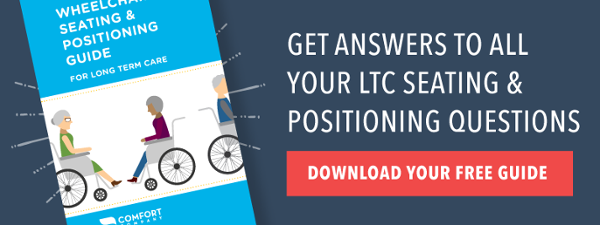Part 18 in our LTC Seating & Positioning series intended to shed some light on the mystery of seating and positioning in the LTC setting. See the rest of the blog posts in the following links: Part 1 (Best Wheelchair Options in LTC), Part 2 (Posture Problems), Part 3 (Posterior Pelvic Tilt), Part 4 (Anterior Pelvic Tilt), Part 5 (Pelvic Obliquity), Part 6 (Pelvic Rotation), Part 7 (Fixed vs Flexible Postural Abnormalities), Part 8 (Windswept Posture), Part 9 (Incorrect Seating Dimensions), Part 10 (Issues with Current Wheelchair System: Seat-to-Floor-Height), Part 11 (Issues with Current Wheelchair System: Back Support), Part 12 (Issues with Current Wheelchair System: Legrest), Part 13 (Issues with Current Wheelchair System: Armrest), Part 14 (Issues with Current Wheelchair System: Head Support), Part 15 (Why is wheelchair seating & positioning important for our residents?), Part 16 (How to Measure: Step of a Seating Eval),Part 17 (How to Measure: Specific Measurements)
Choosing that perfect wheelchair cushion can be overwhelming with the hundreds of choices in the LTC market. But don’t be intimidated! There are really only two questions to ask yourself when selecting a wheelchair cushion:
- Does the resident sit in an abnormal posture that places them at risk to fall from the chair and/or develop a contracture?
- Is the resident at risk for, have an existing, or have a history of pressure injury?
The answers to these questions will guide you to the correct cushion category. Cushions are broken up into three catagories depending on the resident's particular needs.
- Standard
- Skin Protection
- Skin Protection & Positioning
*Typically there is a fourth category for positioning only cushion. We believe that all residents who sit with a postural abnormality are at risk for wound development due to peak pressures on the bony prominences. Therefore, all positioning cushions SHOULD have skin protection properties.
Here are some things to consider when choosing the type of cushion:
| Standard | Skin Protection | Skin Protection & Positioning |
| Resident has sufficient balance and strength to maintain goods posture for long periods of time | Resident has comorbidities that place their skin at risk for breakdown (Diabetes, vascular insufficiency, nutritional defiency, etc) | Resident has comorbidities that place their skin at risk for breakdown (Diabetes, vascular insufficiency, nutritional deficiency, etc.) |
| Can independently reposition self | Difficulty repositioning self | Poor balance and weak core, pelvic, and LE musculature |
| Ability to perform independent pressure relief | Difficulty with performing independent pressure relief | Minimal to no ability to reposition self |
| No skin breakdown or has a Stage 1 diagnosis | At significant risk for a wound or has a wound at any stage | Minimal to no ability to perform independent pressure relief |
| No significant postural abnormality | May or may not be mobile | Sit in one of the 5 postural abnormailites |
| Resident has good sensation | Impaired sensation | At significant risk for a wound or has a wound at any stage |
| May or may not be incontinent | Incontinent | Limited mobility or immobile |
| For short-term residents working on ambulation | Skin at risk due to prolonged sitting in wheelchair > 4 hours per day | Imparied sensation |
| Long-term resident that uses their chair minimally | Incontinent | |
| CONTRACTURE RISK from prolonged sitting in a postural abnormality | ||
| FALL RISK from chair | ||
| Progressive disorders | ||
| Dementia | ||
| Neurological impairment |
**Remember to consider your resident’s functional needs, abilities, and risk areas when choosing the most appropriate wheelchair cushion.
We understand how difficult it is to choose a wheelchair cushion when faced with hundreds of options. We have developed specific resources to narrow down the options and provide you with a premium selection that can meet any of your resident’s needs. Check out our decision tree and cushion comparison chart in our LTC Product Selection Guide for our top picks in each category.

Ana Endsjo, MOTR/L, CLT
Clinical Education Manager LTC Division
Ana Endsjo has worked as an occupational therapist since 2001 in a variety of treatment settings. She has mainly worked with the geriatric population, dedicated to the betterment of the treatment of the elderly in LTC centers. Her focus has been on seating and positioning and contracture management of the nursing home resident. With this experience, her hope is to guide other therapists, rehab directors, nurses, and administrators through educational guides, blogs, webinars, and live courses in her role as Clinical Education Manager for the long term care division.

